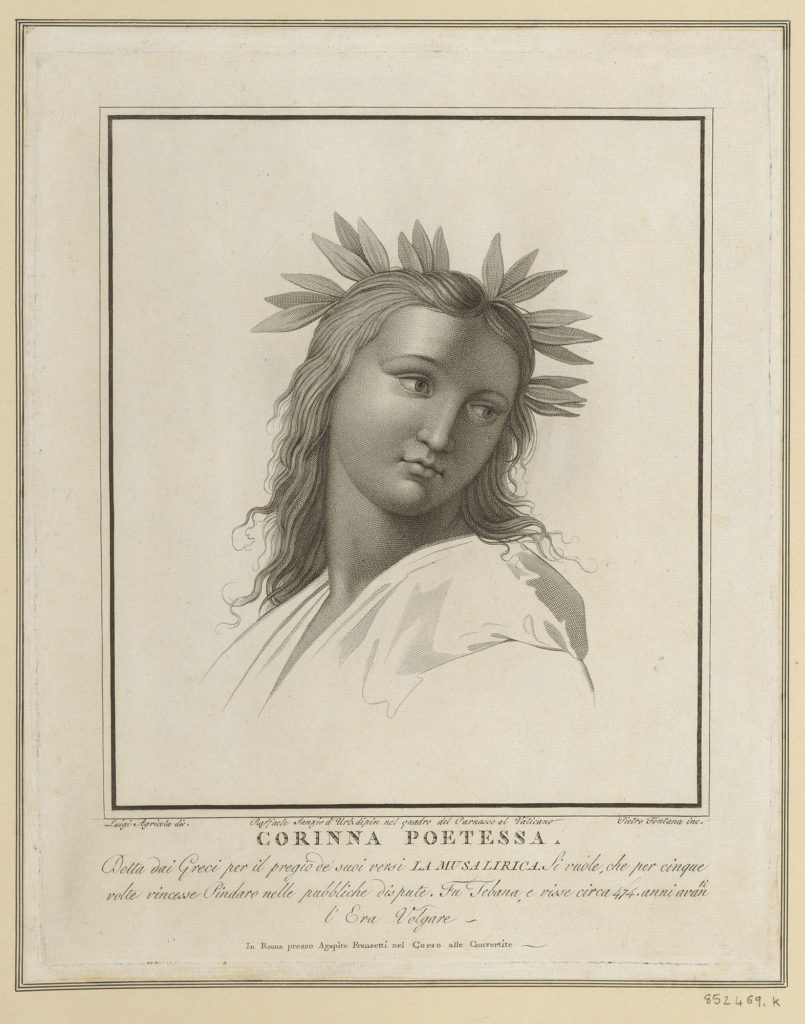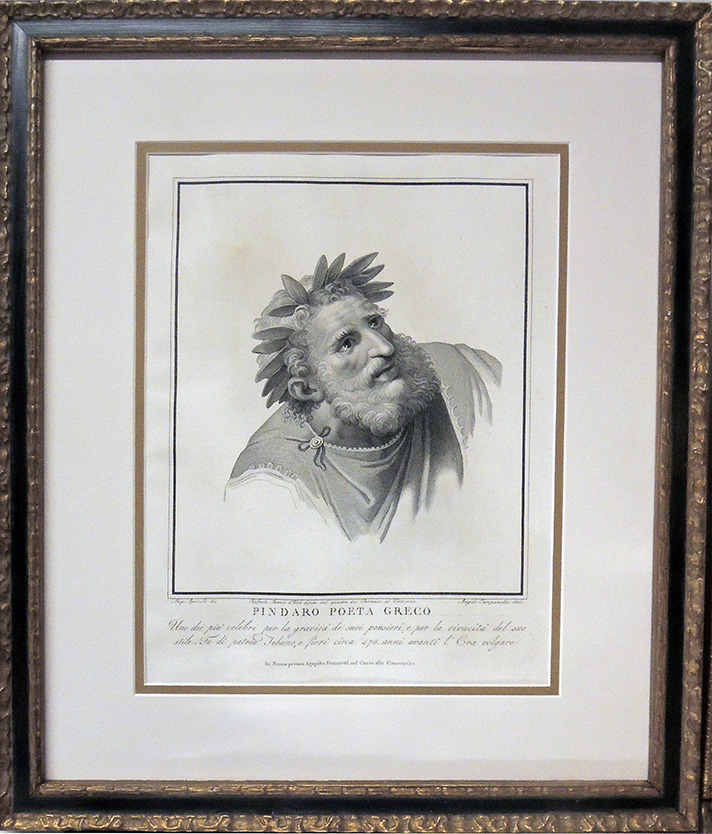2022.05.09 | By Gregory Nagy
§0. What Pausanias says here about the status of Corinna as a lyric poet helps explain the non-canonical status of this poetic figure in contrast to the canonical status of Pindar. The contrast has to do with the dialects of Corinna and of Pindar as described by Pausanias, who is saying here that Corinna’s songs were composed in a dialect that he describes as ‘Aeolic’, while Pindar’s songs were composed in ‘Doric’.


{9.22.3} Κορίννης δέ, ἣ μόνη δὴ ἐν Τανάγρᾳ ᾄσματα ἐποίησε, ταύτης ἔστι μὲν μνῆμα ἐν περιφανεῖ τῆς πόλεως, ἔστι δὲ ἐν τῷ γυμνασίῳ γραφή, ταινίᾳ τὴν κεφαλὴν ἡ Κόριννα ἀναδουμένη τῆς νίκης ἕνεκα ἣν Πίνδαρον ᾄσματι ἐνίκησεν ἐν Θήβαις. φαίνεται δέ μοι νικῆσαι τῆς διαλέκτου τε ἕνεκα, ὅτι ᾖδεν οὐ τῇ φωνῇ τῇ Δωρίδι ὥσπερ ὁ Πίνδαρος ἀλλὰ ὁποίᾳ συνήσειν ἔμελλον Αἰολεῖς, καὶ ὅτι ἦν γυναικῶν τότε δὴ καλλίστη τὸ εἶδος, εἴ τι τῇ εἰκόνι δεῖ τεκμαίρεσθαι.
{9.22.3} Corinna, a woman, and the only person in [the city of] Tanagra who, as-I-have-by-now-discovered [dē], [is known to have] composed [poieîn] [lyric-] songs [noun āisma (in the plural), derived from the verb āidein/aeidein ‘sing’]—this woman has a tomb [mnēma] situated in a conspicuous part of the city [polis] [of Tanagra]. And, in the [public-] gymnasium [of the city] there is a painting [graphē] of her. There she is, Corinna, binding her head with a ribbon to signal the victory she won over Pindar in Thebes by way of a [lyric-] song [noun āisma (in the singular), derived from the verb āidein/aeidein ‘sing’]. It seems to me that she was victorious not only because of her dialect [dialektos]—I say this because she sang [verb āidein/aeidein ‘sing’] not in Doric speech like Pindar, but in whatever speech Aeolians would understand [sun-(h)ienai]—but also because she was, in comparison to other women who existed back then, the most beautiful of them all in her looks, if one is to use-as-evidence [tekmairesthai] the image [eikōn] [of her in the painting on display].
§1. There is an asymmetry here, since Corinna as a native of the city of Tanagra and Pindar as a native of the city of Thebes are thus both natives of Boeotia, and Boeotians were native speakers of Aeolic. And, in the case of Corinna, the dialect we see when we actually read the surviving fragments of texts attributed to her is in fact Aeolic—the Boeotian variety of Aeolic, as linguists today can verify. By contrast, the dialect we see when we read the texts attributed to Pindar is ‘Doric’—though this kind of Doric is a poetic blend of dialectal features that are mostly Doric, yes, but also partly Aeolic. Still, it is fair to say that the poetic language of Pindar is dominantly Doric—though it is also recessively Aeolic. In any case, Pausanias is right: the poetic language of Pindar cannot be described as Aeolic. And, more than that, it is an empirical fact, again verified by linguists, that the poetic language of Pindar cannot be connected directly to his own origins as a native speaker of Aeolic—the Boeotian variety of Aeolic. After all, this poetic blend of Doric-Aeolic features is characteristic not only of Pindar’s songs but also of kindred songs composed by contemporary rival poets whose native dialect was not at all Aeolic or even Doric, such as Simonides and Bacchylides, both natives of the island of Keos, where the spoken dialect of the population was neither Doric nor Aeolic but Ionic.
§2. Alongside the asymmetry, noted by Pausanias, between Corinna and Pindar when it comes to the divergence of the dialects that shape their songs, there is also an element of symmetry, also noted by Pausanias, when it comes to the convergence we see in the reception of these songs in Boeotia, the native land of both these poetic figures. I point to the fact that Pausanias, after highlighting at 9.22.3 the tomb of Corinna in Tanagra, goes on to highlights soon thereafter, at 9.23.2–4, the tomb of Pindar in Thebes. As I argued in my commentary on Pausanias 9.23.2–4, where we read about the tomb of Pindar (Nagy 2022.05.02), the tomb itself marks the site where this poetic figure is worshipped as a cult hero. Similarly, I now argue that the tomb of Corinna as described by Pausanias at 9.22.3 marks the site where this poetic figure is likewise worshipped as a cult hero (such an argument is relevant to the incisive comments of Johanna Hanink 2018:237–238 on Pausanias 9.22.3).
§3. In Boeotia, then, whether we are thinking of Tanagra, the native city of Corinna, or of Thebes, the native city of Pindar, we see a convergence in the reception of their songs. This convergence is made explicit in the hero cults of these two natives of Aeolic Boeotia. To be contrasted, however, is a radical divergence in reception if we shift our perspective from Boeotia to Athens. As I have argued in a detailed essay (Nagy 2019:110, = §46 in the online version, Nagy 2021.11.29), the songs of Corinna were excluded from the Athenian canon of “lyric” songs as performed at the festival of the Panathenaia in Athens, whereas the songs of Pindar—as also the songs of Simonides and Bacchylides, for example—were prominently included. The dialectal blend in the poetic language of these poets—Pindar as well as Simonides and Bacchylides—was familiar enough to Athenian audiences. By contrast, the unblended Aeolic dialect of Boeotian Corinna was simply too unfamiliar.
§4. To back up this argument, I should point out that the Doric features of choral lyric in Athenian State Theater were not all that different from the Doric features of, say, a Pindaric song. I can go even further: in my essay on the Athenian canon of “lyric” songs (Nagy 2019:97, = §10 in the online version, Nagy 2021.11.29) I have argued that the Aeolic features that we see in the songs of Sappho and Alcaeus, as mediated and attenuated by the transmission of these songs in the Ionic song culture represented by the poet Anacreon in Ionian Samos and later by the same poet in Athens, had become familiar enough for a successful reception of Sappho and Alcaeus into the canon of Athenian song culture. But not so with Corinna: her unblended Boeotian diction was rejected from the Athenian canon. Corinna had to wait for a post-Athenian reception, in the Hellenistic era and beyond.
§5. But Corinna will have her revenge. Although she loses in Athens, she will win in Boeotia—and not only in Boeotian Tanagra but even in Boeotian Thebes. Even Pindar, native of Thebes, has to take second place in Thebes to Corinna, native of Tanagra, whose uncompromising Boeotian dialect bests Pindar’s compromised dialectal blend in a mythologized poetic showdown that takes place not in Tanagra but on Pindar’s home ground, in Thebes, where he is worshipped as a cult hero. There is some poetic justice to be seen here, I think, in this narrative reported by Pausanias about a victory of Corinna over Pindar in a mythologized poetic contest that needed to take place not on her own home ground, defined by her own hero cult, but on the home ground of Pindar himself, whose prestige she thus outshines at least in one way: even if she loses to Pindar everywhere else in the world, she will defeat him on his own home ground.
Bibliography
Goldschmidt, N., and B. Graziosi, eds. 2018. Tombs of the ancient poets: Between literary reception and material culture. Oxford.
Hanink, J. 2018. “Pausanias’ Dead Poets Society.” In Tombs of the ancient poets: Between literary reception and material culture (ed. N. Goldschmidt and B. Graziosi ) 235–250. Oxford.
Nagy, G. 2013.The Ancient Greek Hero in 24 Hours. Cambridge, MA. http://nrs.harvard.edu/urn-3:hul.ebook:CHS_NagyG.The_Ancient_Greek_Hero_in_24_Hours.2013.
Nagy, G. 2018.12.06. “Previewing an essay on the shaping of the Lyric Canon in Athens.” Classical Inquiries. https://classical-inquiries.chs.harvard.edu/previewing-an-essay-on-the-shaping-of-the-lyric-canon-in-athens/.
Nagy, G. 2019. “On the Shaping of the Lyric Canon in Athens.” In The Reception of Greek Lyric Poetry in the Ancient World: Transmission, Canonization and Paratext, ed. B. Currie and I. Rutherford, 95–111. Vol. 5 of Studies in Archaic and Classical Greek Song. Mnemosyne Supplements 430. Leiden. https://doi.org/10.1163/9789004414525_005.
Nagy, G. 2021.04.30. “On the idea of dead poets as imagined by T. S. Eliot, compared with ideas about reperformance, Part III.” Classical Inquiries. https://classical-inquiries.chs.harvard.edu/on-the-idea-of-dead-poets-as-imagined-by-t-s-eliot-compared-with-ideas-about-reperformance-part-iii/.
Nagy, G. 2021.11.29. “On the Shaping of the Lyric Canon in Athens.” Classical Continuum. https://continuum.fas.harvard.edu/on-the-shaping-of-the-lyric-canon-in-athens/.
Nagy, G. 2022.05.02. “Pausanias 9.23.2–4, on the tomb of Pindar,” Classical Continuum. https://continuum.fas.harvard.edu/pausanias-9-23-2-4-on-the-tomb-of-pindar/.